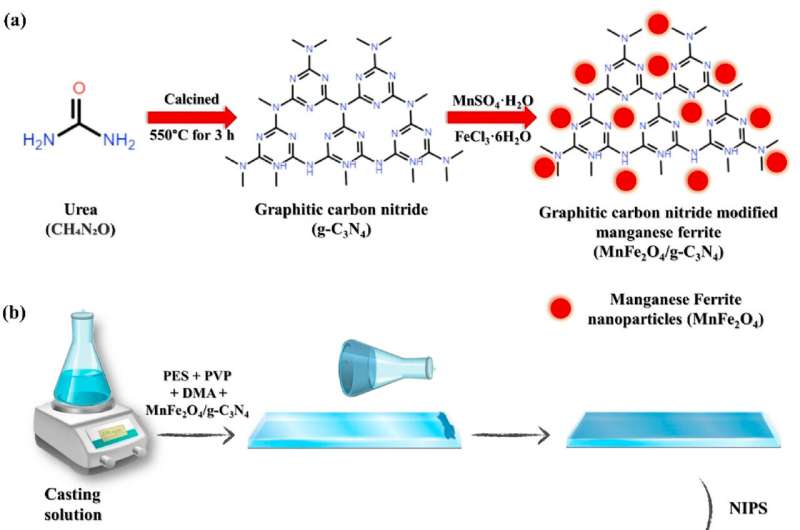This article has been reviewed according to Science X's editorial process and policies. Editors have highlighted the following attributes while ensuring the content's credibility:
fact-checked
trusted source
proofread
Manganese nanoparticles can more than double availability of world's potable water, say scientists

Manganese ferrite nanoparticles could lead to a substantial surge in the availability of drinking water globally when used to modify the filtering sheets currently used in water treatment plants, according to scientists.
"Our study records some extraordinary results. The top-performing membrane, containing 2 wt.% composite material, achieved a water flux of 351.4 LMH, which is 2.6-fold higher than the pristine PES membranes," said study co-author Dr. Ismail Almanassra, a research associate at the University of Sharjah's Institute for Science and Engineering.
PES or polyethersulfone membranes are vital for water treatment plants since they function as barriers allowing potable water to pass and preventing unwanted substances getting through them. They filter salts, impurities, and other unwanted particles from water.
"The significance of this project lies in its potential to revolutionize water treatment processes, offering technological, economic, environmental, and health benefits on a broad scale," added Dr. Almanassra.
The study, published in the Journal of Membrane Science, shows the scientists to have developed "UF membranes with superior water flux and rejection rates" and with the ability to address key inefficiencies in current water treatment methods.
"The project effectively mitigates biofouling, reducing maintenance and operational costs while contributing to environmental sustainability through more efficient water management," added Dr. Almanassra.
UF or ultrafiltration membranes are widely used in water treatment plants across the globe. They are likewise conventionally and typically used in desalination projects as well as groundwater pretreatment, food processing, industrial chemical separation and wastewater treatment.
UF membranes also work as a barrier to suspend endotoxins, viruses and other solids and pathogens to produce potable water with high purity and low density of silt. They are mostly constructed of either polymeric materials or ceramic.
Dr. Almanassra said water treatment and desalination plants currently encounter several challenges "especially during the pretreatment stage where polymer-based ultrafiltration (UF) membranes are used for decontamination.
"One major issue is biofouling, where biological materials accumulate on the membrane surface, negatively impacting permeate flux and water quality."
Biofouling adversely impacts the efficiency and durability of UF membranes used in water treatment plants. It is caused by microorganisms which pollute and contaminate the water, lower production of potable water, and cover, block, or damage membrane surfaces.
This is an issue operating engineers still grapple with. To address it, they usually pursue two solutions. In the first, they increase the operating pressure on FU membranes to maintain permeability and water production. In the second, they are forced to frequently replace the biofouled membranes.

However, the study authors demonstrate that both solutions lead to higher operational and maintenance costs. As researchers from diverse backgrounds, they work to innovate and engineer UF membranes by integrating hydrophilic materials to tackle biofouling effectively and reduce long-term expenses.
"This approach not only enhances permeate flux and contaminant removal rates but also significantly reduces the impact of biofouling over time, leading to more efficient and cost-effective water treatment solutions," said Dr. Almanassra.
The scientists' innovation lies in their success in modifying 2D graphitic carbon nitride with manganese ferrite nanoparticles to be used as nanofillers for PES UF membranes. The membranes were fabricated with different mass loadings of the additive ranging between 0.5 and 3 wt.%, via phase inversion method.
Prior to testing and evaluation, these films were characterized using different techniques to study their morphology, surface roughness, physiochemical, and mechanical attributes. Following this, the membranes were tested with fouling agents known to cause fouling over time.
"In terms of rejection and anti-fouling capacity, our membrane excelled, rejecting over 95% of HA and BSA. Impressively, even after hydraulic washing, the membrane maintained a recoverability ratio exceeding 88%.
"The integration of hydrophilic materials marks a significant advancement in material science, with potential applications beyond water treatment. Ultimately, this project improves public health by providing cleaner, safer water and offers scalable solutions to global water scarcity and pollution challenges."
More information: Lubna Jaber et al, Pioneering Biofouling Resistant PES UF Membrane with MnFe2O4/g-C3N4 Nanocomposite: Insight into Mechanisms and Fouling Dynamics, Journal of Membrane Science (2023). DOI: 10.1016/j.memsci.2023.122259
Provided by University of Sharjah





















